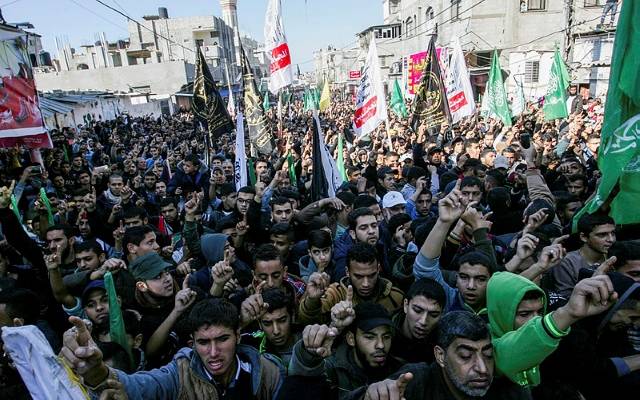The only real way to alleviate the humanitarian crisis in Gaza is to offer the Gazans what they really want – a better life elsewhere.
By: Martin Sherman
The recent spate of reports, warning of a looming “humanitarian crisis” in Gaza, underscores the painfully obvious: The endeavor, spanning almost a quarter century, to transform the coastal enclave of the Gaza Strip into a self-governing Arab entity has failed–resoundingly and irretrievably.
The magnitude of this failure can be gauged from a recent document composed by the Congressional Research Service entitled, “U.S. Foreign Aid to the Palestinians”: “Since the establishment of limited Palestinian self-rule in the West Bank and Gaza Strip in the mid-1990s, the U.S. government has committed more than $5 billion in bilateral economic and non-lethal security assistance to the Palestinians, who are among the world’s largest per capita recipients of international foreign aid.”
The Futility of International Aid
The report goes on to stipulate the intended objectives of this generous aid: “Successive Administrations have requested aid for the Palestinians in apparent support of at least three major U.S. policy priorities of interest to Congress:
Promoting the prevention or mitigation of terrorism against Israel ..;
Fostering stability, prosperity, and self-governance …that may incline Palestinians toward peaceful coexistence with Israel…”
Meeting humanitarian needs…”
Given the grim realities today, this aid has clearly failed miserably in achieving any, and all, of its declared goals!
Neither stability, nor prosperity, nor effective self-government have been in any way significantly fostered. Quite the reverse.
The motivation for terror attacks against Israel by Hamas and other Palestinian-Arab terror organizations have been neither prevented nor mitigated. Indeed, there are few illusions in Israel that a other round of fighting is merely a question of “when”, not “if”.
Thus, despite decades of generous international goodwill, all the Palestinian-Arab leadership has managed to create is an untenable, divided entity, crippled by corruption and cronyism, with a dysfunctional polity and a feeble economy with a minuscule private sector and bloated public one, and utterly dependent on foreign aid.
Moreover, humanitarian needs have not been met in any meaningful manner.–with the entire civilian infrastructure system teetering on the cusp of collapse– with perennial power outages, undrinkable water supplies, failing sanitation services, and awash in uncontrolled and untreated flows of raw sewage.
Powers Outages, Undrinkable Water, Untreated Sewage
Moreover, power shortages have crippled the operation of a new desalination plant and sewage treatment site, and undermine the operation of regular sanitation services.
Significantly, the reasons for the shutdowns/disruptions are not related to Israel’s security quarantine of Gaza, but rather to intra-Palestinian quarrels between the Fatah-controlled Palestinian Authority and Hamas in Gaza; and to Hamas’s own priorities in the use of electrical power.
The grave results of this dysfunctional governance are not difficult to discern.
Both international and Israeli bodies estimate “that some 96 percent of water in the Gaza Strip is now undrinkable after the collapse of the enclave’s main aquifer”.
Thus, with much of the sewage conveyance pipes in a state of disrepair, leaking into the coastal aquifer, Gaza’s sole source of natural water; with the aquifer itself being depleted at three times its recharge rate from rainfall; with massive flows of untreated sewage channeled directly into the sea, making the beaches and swimming a distinct health hazard, future prospects for the average Gazan look bleak indeed—with little hope for improvement on the horizon.
The Only Real ‘Reconstruction’ in Town
Of course, many of Israel’s detractors will attempt to lay the blame for this dismal situation on the “Occupation” and the “Siege”. But, this is merely a flimsy pretext that is sounding increasingly hollow. Indeed, as mentioned the entire crisis is a result of intra-Palestinian decisions regarding resource allocation and taxation—as unequivocally affirmed by examining just how the Palestinian-Arabs in Gaza have chosen to invest their energies and divert their resources.
Thus, high level Israeli sources revealed that Hamas was seizing over 90% of cement supplies entering into Gaza for its own purposes, such as construction of terror tunnels. Moreover, Hamas’s efforts were not confined to underground terror installations. The organization invested considerable effort in replenishing and enhancing its overhead weaponry.
Thus, Hamas Political Bureau Member, Fathi Hammad, proudly informed Al Aksa TV: “our Jihadi, ‘Izz Al-Din Al-Qassam units have become an army, Allah be praised…This army has its own industry…These are advanced missiles. If you look into the missile or weapon industries of developed countries, you will find that Gaza has become the leading manufacturer of missiles among Arab countries…”
With “commendable” commercial enterprise, he went onto propose a new export industry for the beleaguered enclave: “We are prepared to sell them (to Arab countries) – so that they will launch them against the Jews…” Significantly, according to reported IDF assessments, by the beginning of 2017, Hamas’s “military capabilities had been restored to their pre-2014 war strength”—which is, of course, an impressive feat of “reconstruction”.
So, despite Israeli restrictions, it appears that, where mobilizing against the hated “Zionist entity” is concerned, Gazans seem able to find the ingenuity and productive energies that evidently elude them in other fields of endeavor.
Gaza: What Einstein Would Have Said?
The current situation in Gaza–and the accompanying misery—are the direct result of the misguided attempt to foist statehood on the Palestinian-Arabs.
Accordingly, it is hardly surprising to learn that polls conducted by Palestinian institutes consistently show that almost half (and occasionally more than half) of Gazans would like to emigrate—even without there being a tangible economic incentive offered.
It was Albert Einstein who famously said that one could not solve a problem with the level of thinking that created it. The problem of Gaza was, irrefutably, created by the belief that land could be transferred to the Palestinian-Arabs to provide them a viable opportunity for self-governance. Accordingly, the problem of Gaza cannot be solved by persisting with ideas that created it – i.e. persisting with a plan to provide the Palestinian-Arabs with land for self-governance. This concept must, therefore, be abandoned for any lasting resolution to be possible.
The Need to Restructure Humanitarian Aid
Clearly then, persisting with humanitarian aid, as in the past, will yield essentially similar results to those of the past. Any improvements in the humanitarian conditions will be at best marginal, probably imperceptible.
The only real way to alleviate the humanitarian crisis in Gaza is to offer the Gazans what they really want – a better life elsewhere, out of harm’s way, free from the clutches of the cruel, corrupt cliques, who have lead them from disaster to disaster for decades.
Thus, rather than pouring millions into inoperative desalination plants and rusting sewage treatment works, the aid should be in the form of generous individual relocation grants to allow non-belligerent Gazans to seek a safer, more secure future elsewhere, outside the “circle of violence” that inevitably awaits them if they stay.
This should be the real humanitarian effort to effectively eliminate the suffering in Gaza. This should be the call to the international community: Let their people go!
MAKE THE LAND OF ISRAEL EVEN MORE BEAUTIFUL!
PLANT YOUR VERY OWN FRUIT TREES IN ISRAEL!
Farmers near the Gaza border lost family, friends and workers. Spring is here, and they desperately need help to replant the farms. Join us in blessing the People and Land of Israel.
“I will ordain My blessing for you…” (Leviticus 25:4)























